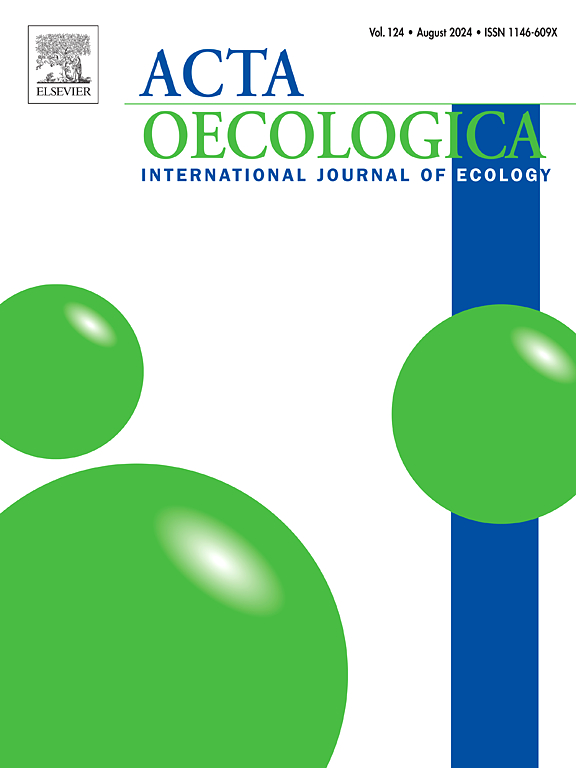斯里兰卡热带雨林冠层开度随海拔和方位角的变化
IF 1.3
4区 环境科学与生态学
Q3 ECOLOGY
Acta Oecologica-International Journal of Ecology
Pub Date : 2025-05-10
DOI:10.1016/j.actao.2025.104084
引用次数: 0
摘要
太阳辐射能是潮湿热带环境中森林生长的一个限制因素。冠层开放度,定义为从地面上看,透过森林冠层可见的无遮挡天空部分,影响林下光照状况和森林的更新动态。在这项工作中,我们的目标是确定斯里兰卡热带雨林(TRFSLs)的冠层开度随海拔和方位角(即指南针方向)的变化。此外,我们还探讨了由坡向和地形变化引起的不同辐射制度对观测到的冠层开度随方位角变化的可能影响。我们从我们的数据中寻找证据来支持这样的假设,即森林冠层将更大的叶面积分配给面向方位角的冠层段,这些冠层段接受更大的太阳辐射。采用半球面摄影技术,在海拔117 ~ 2132 m的10个1公顷的永久样地进行了林冠影像的采集。以18个天顶角(ZnA) × 8个方位角(AzA)段为界,利用图像分析方法确定了冠层半球144个扇区的可见天空(Vsky)比例。冠层开度随海拔的增加而增加,以全半球的Vsky来量化。冠层叶面积指数随海拔高度线性降低,与Vsky呈负相关。10个样地中有8个样地的冠层开度(ZnA = 0°~ 30°)东部(ZnA = 90°)低于西部(ZnA = 270°),差异在3% ~ 52%之间。大部份地点的估计太阳辐照度水平和投影阴影图,以及部分地点的现场太阳辐照度测量结果显示,正午前的辐射量高于正午后的辐射量。在西部Vsky(0-30)较低的2个样地,中午前的太阳辐照度较高,可能是由于样地东部附近的山脉在中午前遮挡了森林冠层的东侧。这些结果为我们的假设提供了部分支持,即森林冠层将更大的叶面积分配给接收更大辐照度的一侧。然而,冠层北部(AzA = 0°)和南部(AzA = 180°)的Vsky(0-30)之间没有一致的差异。因此,我们得出的结论是,我们的观测结果并不能提供确凿的证据来证实森林冠层将更大的叶面积分配给接受更大太阳辐射的冠层方位角段的假设。本文章由计算机程序翻译,如有差异,请以英文原文为准。
Variation of canopy openness of tropical rainforests of Sri Lanka with altitude and azimuth angle
Solar radiation energy is a limiting factor for forest growth in humid tropical environments. Canopy openness, defined as the unobstructed visible sky fraction through a forest canopy when viewed from the ground level, influences the understory light regime and regeneration dynamics of a forest. In this work, our objectives were to determine the variation of canopy openness of tropical rainforests of Sri Lanka (TRFSLs) with altitude and azimuth (i.e. the compass direction). Furthermore, we explored the possible influence of differential radiation regimes, caused by variation of aspect and topography, on the observed variations in canopy openness with azimuth. We sought evidence from our data to support the hypothesis that forest canopies allocate greater leaf area to canopy segments facing azimuth angles which receive greater solar radiation. Hemispherical photography was used to capture canopy images of TRFSLs in ten 1 ha permanent sampling plots across an altitudinal range from 117 m to 2132 m above mean sea level. Fraction of visible sky (Vsky) in 144 sectors of the canopy hemisphere, defined by 18 zenith angle (ZnA) × 8 azimuth angle (AzA) segments, was determined using image analysis. Canopy openness, quantified as Vsky of the overall hemisphere, increased with increasing altitude. Canopy leaf area index, decreased linearly with altitude and had a negative relationship with Vsky. In eight out of the ten plots, canopy openness of the top one-third (ZnA = 0°–30°) of the hemisphere (Vsky(0-30)) was lower on the east (AzA = 90°) than on the west (AzA = 270°) with the difference ranging from 3 % to 52 %. Estimated solar irradiance levels and maps of projected shade on a majority of these plots and on-site solar irradiance measurements on selected plots showed that radiation receipt was greater during the pre-noon period than during the post-noon period. In the two plots which showed lower Vsky(0-30) on the west, pre-noon solar irradiance was higher probably due to the presence of nearby mountains to the east of the plots which shaded the eastern side of the forest canopies during the pre-noon period. These results provide partial support for our hypothesis that forest canopies allocate greater leaf area to the side which receives greater irradiance. However, there was no consistent difference between Vsky(0-30) the northern (AzA = 0°) and the southern (AzA = 180°) canopy segments. Therefore, we conclude that our observations do not provide conclusive evidence to confirm the hypothesis that forest canopies allocate greater leaf area to canopy azimuth segments which receive greater solar radiation.
求助全文
通过发布文献求助,成功后即可免费获取论文全文。
去求助
来源期刊
CiteScore
3.60
自引率
0.00%
发文量
57
审稿时长
>0 weeks
期刊介绍:
Acta Oecologica is venue for the publication of original research articles in ecology. We encourage studies in all areas of ecology, including ecosystem ecology, community ecology, population ecology, conservation ecology and evolutionary ecology. There is no bias with respect to taxon, biome or geographic area. Both theoretical and empirical papers are welcome, but combinations are particularly sought. Priority is given to papers based on explicitly stated hypotheses. Acta Oecologica also accepts review papers.

 求助内容:
求助内容: 应助结果提醒方式:
应助结果提醒方式:


